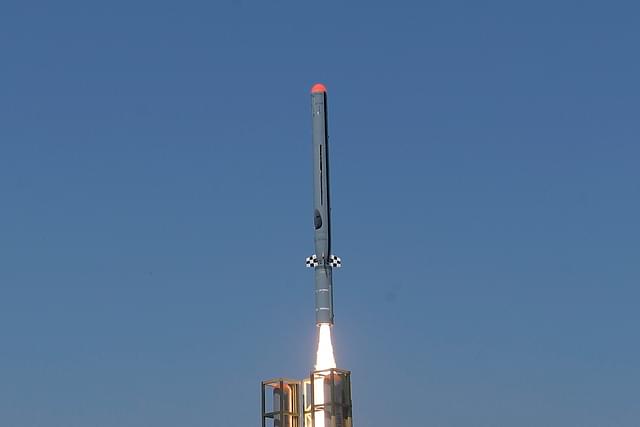Defence
India's Indigenous Technology Cruise Missile Demonstrates Sea Skimming Capability
Nishtha Anushree
Apr 18, 2024, 04:45 PM | Updated 07:13 PM IST
Save & read from anywhere!
Bookmark stories for easy access on any device or the Swarajya app.

Defence Research and Development Organisation (DRDO) conducted a successful flight test of the Indigenous Technology Cruise Missile (ITCM) on Thursday (18 April).
ITCM is a long-range subsonic cruise missile powered by indigenous propulsion system. It is also equipped with advanced avionics and software to ensure better and reliable performance.
The missile is developed by the Bengaluru-based DRDO laboratory Aeronautical Development Establishment (ADE) along with contributions from other laboratories and Indian industries.
In the test conducted at the Integrated Test Range (ITR), Chandipur off the coast of Odisha, all subsystems performed as per expectation. The missile followed the desired path using waypoint navigation.
In a very low altitude sea-skimming flight, the reliable performance of the indigenous propulsion system developed by the Gas Turbine Research Establishment (GTRE), Bengaluru was also established.
As Swarajya explained earlier, the term "sea-skimming" refers to a tactical approach employed by certain missiles or aircraft to navigate at a low altitude, closely following the contour of the ocean's surface.
This technique is employed to minimize the radar signature and increase the chances of evading detection by enemy radar systems. Sea-skimming missiles or aircraft fly at altitudes typically ranging from a few meters to a few dozen meters above the water, making it challenging for radar systems to track them accurately.
By hugging the sea surface, these platforms exploit the "ground clutter" effect, where radar signals bounce off the water's surface, making it difficult to differentiate the incoming threat from the surrounding environment.
Sea-skimming capabilities provide a significant tactical advantage by enhancing the chances of successful target engagement by reducing the time the enemy target has to take defensive measures against the incoming missile.
The missile performance was monitored by several Range Sensors like Radar, Electro-Optical Tracking System (EOTS) and Telemetry deployed by ITR at different locations to ensure complete coverage of the flight path.
The flight of the missile was also monitored from the Su-30-Mk-I aircraft of the Indian Air Force (IAF). The test was witnessed by many senior scientists from various DRDO laboratories and representatives from the production partner.
Defence Minister Rajnath Singh congratulated and said that the successful development of indigenous long-range subsonic cruise missiles powered by indigenous propulsion is a major milestone for Indian defence R&D.
Save & read from anywhere!
Bookmark stories for easy access on any device or the Swarajya app.
Nishtha Anushree is Senior Sub-editor at Swarajya. She tweets at @nishthaanushree.
Introducing ElectionsHQ + 50 Ground Reports Project
The 2024 elections might seem easy to guess, but there are some important questions that shouldn't be missed.
Do freebies still sway voters? Do people prioritise infrastructure when voting? How will Punjab vote?
The answers to these questions provide great insights into where we, as a country, are headed in the years to come.
Swarajya is starting a project with an aim to do 50 solid ground stories and a smart commentary service on WhatsApp, a one-of-a-kind. We'd love your support during this election season.
Click below to contribute.





